|
Curtiss Aeronola and the Post War Effect
by Keith Wright
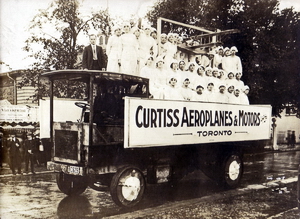
|
|
Photograph of a Curtiss float
in a 1918 Toronto Victory Bond parade.
(Collection of Bill and Betty Pratt)
|
|
|
As is well known, at the height of the
gramophone production craze during the
late teens and the twenties of the twentieth
century, talking machines were being produced
by a plethora of companies in Canada. Some
had definite bona fides to do so, such as Casavant
Frères of Quebec, who produced world-class
pipe organs, and the various piano manufacturers
such as The Amherst Piano Factory of Nova
Scotia and Gerhard Heintzman Ltd. and Mason
& Risch of Toronto. Others had somewhat
tangential expertise, such as the Brantford Piano
Case Company and George McLagan Furniture
Co. Ltd. And then there was the seeming-outlier
among the bunch, Curtiss Aeroplanes and Motors
Ltd. During my research into W.H. Banfield and
Sons, who were machinists and went into the
production of ‘phonograph motors’ and perhaps
whole machines, it dawned on me why Curtiss
would have made such a curious change in
production.
Announced in The Toronto Daily Star on February
12, 1915 was that an aeroplane factory was to be
located in Toronto. “150 Men To Be Employed to
Build Biplanes for Military Purposes,” and
“Pilot to Be Trained Here for the Canadian Contingent
of British Army.”
As noted
“Mr. J.A.D.
McCurdy…has formed a company which will be
in operation almost at once to manufacture these
machines. Mr. McCurdy has been in close touch
with Glen Curtiss…one of the most prominent of
aeroplane builders in the States, and the machines
which will be constructed will be of the standard
Curtiss types…”
And later in the article,
“Along with construction, arrangements will be made
to train pilots to handle the machines…”

|

|
|
Long Branch Aviation School started by Curtiss company, 1915.
(Images courtesy John Boyd Sr. Toronto military training photograph
album from the Toronto Public Archives)
|
|
|
On February 22 the same year, it was reported that
the company received an order for 8 planes from
the Dominion Government. Things continued to
go well for Curtiss/McCurdy as a report later that
same year noted that there was “Money In Aeros”
with the Curtiss company receiving $15,000,000
from Great Britain after having already produced
$6,000,000 worth of aeroplanes and motors in the
previous fiscal year, most of which went to the
British Government. (Another report mentioned
that representatives of the Spanish Government
were buying Toronto-made planes.)
The flying school was located in Long Branch
where the old Lakeview generating station (of the
“four sisters” chimneys fame) later resided and
was, in fact, the very first airport (“aerodrome” at
the time) built in Canada. The school itself was
reported to be the “largest in existence”.
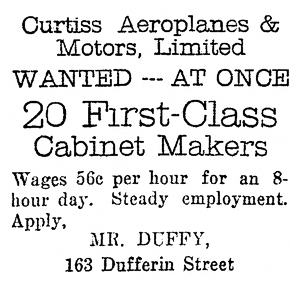
|
|
Curtiss looking for help to build the many
gramophones they were
planning.
(Toronto Daily Star, August 9, 1919 pg 18)
|
|
|
This article is not intended as a review of
Canadian aviation history, but as background.
John Alexander Douglas McCurdy (August 2,
1886 – June 25, 1961) was born in Baddeck,
Nova Scotia and graduated from the University
of Toronto in mechanical engineering and
became the first Canadian to receive a pilot’s
license. In 1907 he joined the Aerial Experiment
Association (AEA), along with another U of T
graduate, Frederick W. “Casey” Baldwin, under
the leadership of Alexander Graham Bell—
who not coincidentally had his summer home
in Baddeck, Nova Scotia and whose one-time
personal secretary was McCurdy’s father. Later
the group recruited Glenn Curtiss, a bicycle
racer who developed an interest in motorcycles
and went into their manufacture. At one time
Curtiss was known as the “fastest man in the
world” after setting an unofficial speed record
on a motorcycle—which went unbroken for 23
years. The AEA experimented with heavier-thanair
machines in Hammondsport, New York and
Baddeck, Nova Scotia. Curtiss would later found
an aeroplane company in the US, which in part
still exists today as Curtiss-Wright.
As noted above, the Curtiss plant in Toronto
was created to manufacture training aircraft for
the British Government. However, according
to the Canadian Aviation Museum,
“Within days of the training program’s approval, on
December 15, 1916, Canadian Aeroplanes was
incorporated for the purpose of providing all
aircraft required by the training schools. The
Canadian-based Imperial Munitions Board,
an organization responsible for awarding war
contracts to Canadian manufacturers, took over a
small airplane manufacturing plant in downtown
Toronto, formerly used by Curtiss Aeroplane &
Motor Limited [possibly the 163 Dufferin Street
location]. But the expanding company soon
outgrew this space and, by May of the following
year, all operations had been moved to a new
plant (still in Toronto).”
It was 1244 Dufferin Street which includes the land
where the Galleria sits today.
As I mentioned before, it was research into W.H.
Banfield and Sons that drew my attention to the
idea of post-war production. Obviously as WWI
ended, the amount of manufacturing capacity for
war material, including human resources, wasn’t
required and the populace could concentrate
on more domestic matters.
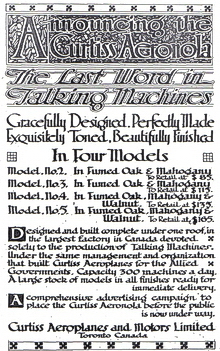
|
|
(Canadian Music Trades Journal,
Volume 20,
No. 2, July 1919)
|
|
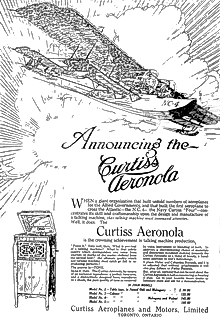
|
|
(Edmonton Journal,
September 27, 1919, pg. 19)
|
|
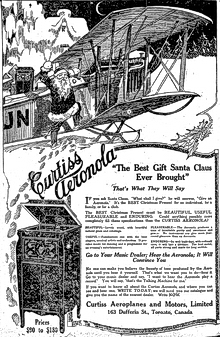
|
|
(Toronto Daily Star,
December 22, 1919, pg. 22)
|
|
|
The major patents
protecting the North American talking machine
triumvirate (Edison, Victor and Columbia) were
expiring and thus the talking machine boom
began. There is a full page in the November
29, 1919 edition of The Globe devoted to
talking machines, pianos and the music industry
in general. On that page there is an article
about how, with Columbia taking over the 11
buildings of Canadian Aeroplanes Ltd. (1244
Dufferin—not the original site of Curtiss)
“there is the assurance of a considerable expansion
of talking-machine manufacture in Canada …
[which] will increase Canadian output from
400 to 500 percent.”
There is an article about
W.H. Banfield and Sons applying the
“war’s big production
lessons…to peace-time business…
The munitions plant…is now working at top
speed on phonograph motors—and phonographs.”
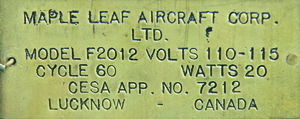
|
|
ID plate from an electric 78 player for sale in 2015.
(Image courtesy of the author)
|
|
|
There is also an article about how a “Stratford
Firm [McLagan] is Forging Ahead, Putting
Phonographs of Wide Variety on the Canadian
Market.” And then, there is an article noting,
“Aeroplane Company Making Phonographs.”
“’We challenge the statement that there is a
dearth of musical education and appreciation in
Canada,’” said Mr. E. Sterling Dean, who is in
charge of advertising for the Curtiss Aeroplanes
and Motors, Limited, which has begun recently
the manufacture of talking machines.” Dean
continues to suggest that “any boy or girl living in
the average home [ can name] the most prominent
violinists of the day or the most famous singers”
to which he “ascribes…the perfecting of the
talking machine, which is within the means
of many more persons than the piano.” The
article continues to claim that Curtiss “which
had been making airplanes for the allies, finding
their factory ideal for the purpose, turned to the
manufacture of talking machines. They obtained
well-known talking-machine experts to assist…
Mr. Dean says that the models…reveal startling
accuracy.”
What else would he say?
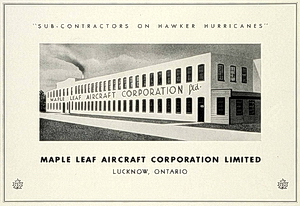
|
|
Image purported to be of the Maple Leaf
Aircraft Corporation
around 1942.
(From an eBay listing, March 2015)
|
|
|
There are employment-wanted adverts in the
Daily Star (August, 1919) and The Globe
(October, 1919) for cabinet makers and others,
for the 163 Dufferin address, who would be
more suited to talking-machine manufacture
than aeroplanes. I do note that they are looking
for finishers as the only motors that have been
mentioned are all from the Newark N.J. thirdparty
MeisselBach—whose motors turn up in
many “off brand” machines. Curtiss must have
had high hopes as an issue of Canadian Music
Trades Journal (October, 1919) claims that
“12,515,000 Advertisements will appear in Press
between now and Christmas.” It sure looks like
there were that many. Then…not so much. I
have found no references to them so far after
1919, until they are included in the “fire sales” of
1929—presumably as used or left-over stock. If
the public didn’t initially take to them, there is a
small cadre of collectors today who have.
Of all the people who have contributed to the
40+ talking-machine brands in the Canadian
Antique Phonograph Project, the Aeronola pilots
are different. They have done more research on
their own than any others and there is a palpable
pride in how they have carefully made sure that
the page lists each of the six known existing
machines with as much detail as possible.
According to Aeronola-owner Carl Swanston,
the company was forced into receivership in
1920 and the facility became the General (car)
Top Company in August of 1920.
“The Curtiss
Company was then managed by Canadian
financier Clement Keys who brought it back to
prosperity sans gramophone production.”
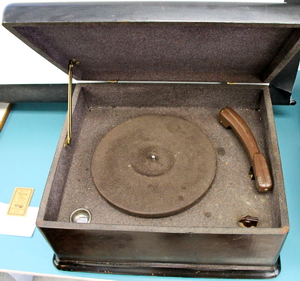
|
|
Electric 78 attachment ostensibly from the Maple Leaf Aircraft
Corporation of Lucknow, Ontario.
(Image courtesy the author)
|
|
|
Finally, I take this opportunity to mention a
later example of the post-war production effect.
In February of 2015 a curious electric 78 rpm
turntable, clearly from the 1940s, showed up at
a meeting of the Canadian Antique Phonograph
Society. It was a typical, lidded attachmentturntable
but on the underside it had a plate that
in part read, “Maple Leaf Aircraft Corp. Ltd.
Lucknow Canada”.
According to the “Furniture Factories Information
Sheet” of the Bruce County Museum and Cultural
Centre,
“In 1898, John Button and H.J. Trevett,
known as Teeswater Furniture Company, moved
their machinery to Lucknow. They specialized in
tables. A modern, fire-proof, concrete building
was completed in 1907. During World War II, the
firm made [war] products under the name Maple
Leaf Aircraft. Following the [war], William
Renaud operated the furniture factory for a short
time.”
In an article about local Lucknow war hero
Warren Wylds, writer Garit Reid notes,
“Before entering the military Wylds worked as a foreman
at the Maple Leaf Aircraft in Lucknow where he
supervised a crew that made hydraulic systems for
landing wheels for military airplanes; one of the
many things made for the military at Maple Leaf.”
I have also found a picture of what is purported
to be the Maple Leaf factory in Lucknow circa
1942 that is labelled, “Sub-contractors on Hawker
Hurricanes.”
No more is known at present about the 78
attachment from Lucknow but it certainly looks
like another example of what would much later be
called the “peace dividend”.
References
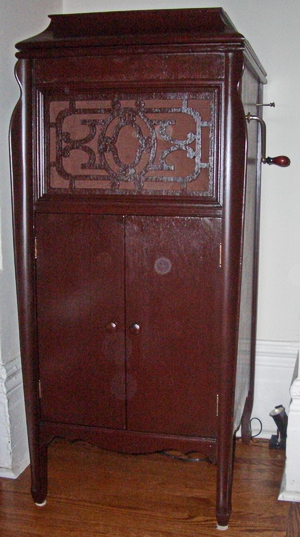
|
|
Aeronola phonograph in the collection of Carl Swanston.
Serial number 5M620, motor number 170523.
|
|
|
- John Boyd Sr. Toronto military training
photograph album, Toronto Public Archives,
Fonds 1548, Series 1418, File 1, Item 31.
- Canada's First Aerodrome, Long Branch
Curtiss Aviation School by Liwen Chen for Heritage Mississauga.
- Toronto Daily Star, May 19, 1908, pg. 3.
- Ibid, March 1, 1909, pg. 2.
- Ibid, July 22, 1909, pg. 3.
- Ibid, August 9, 1919 pg 18.
- Ibid, February 12, 1915, pg 12.
- Ibid, February 22, 1915, pg. 5.
- Ibid, December 15, 1915, pg. 2.
- Ibid, July 14, 1915, pg. 4.
- Ibid, July 15, 1915, pg. 1.
- Ibid, August 9, 1919, pg. 18.
- Ibid, December 22, 1919, pg. 22.
- Ibid, March 27, 1929, pg.2.
- Edmonton Journal, September 27, 1919,
pg. 19.
- The Globe, November 29, 1919, pg 23.
- Canadian Music Trades Journal, Vol. 20,
No. 5, October, 1919, pg. 42.
- Canadian Aeroplanes Ltd. "mini exhibit"
from the Canadian Aviation and Space Museum
- Curtiss Aeronola page from the Canadian Antique Phonograph Project
- Aviation in Canada: The Pioneer Decades, Larry Milberry, CANAV Books, Toronto, 2008.
- Furniture Factories Information Sheet of
the Bruce County Museum and Cultural Centre.
- The Homefront during WWII was just as
important by Garit Reid, Lucknow Sentinel,
Nov. 11, 2009.
- Carl Swanston, personal correspondence with
KW.
|